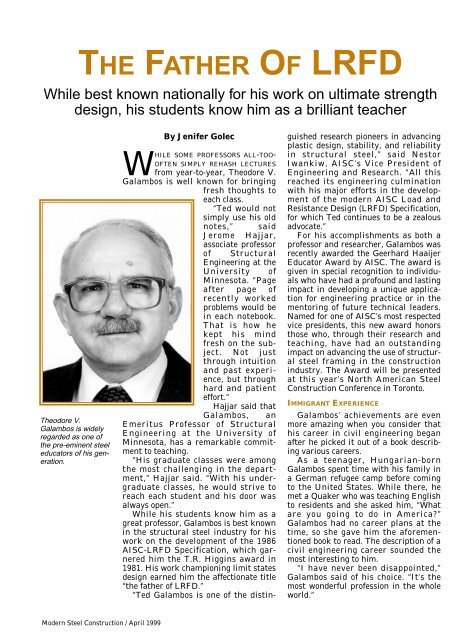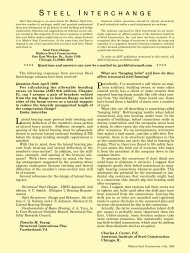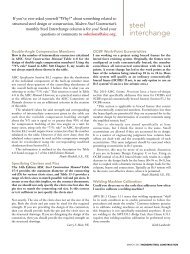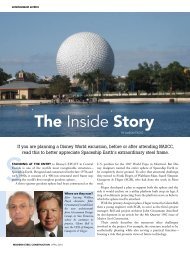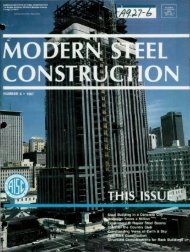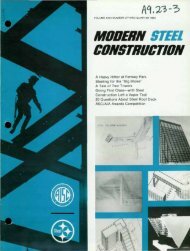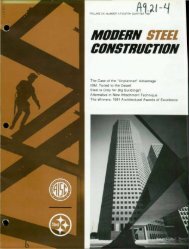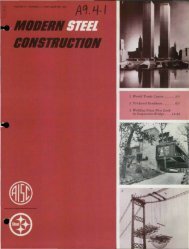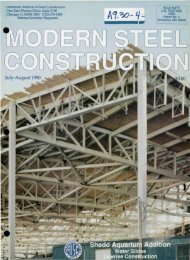THE FATHER OF LRFD - Modern Steel Construction
THE FATHER OF LRFD - Modern Steel Construction
THE FATHER OF LRFD - Modern Steel Construction
You also want an ePaper? Increase the reach of your titles
YUMPU automatically turns print PDFs into web optimized ePapers that Google loves.
<strong>THE</strong> FA<strong>THE</strong>R <strong>OF</strong> <strong>LRFD</strong><br />
While best known nationally for his work on ultimate strength<br />
design, his students know him as a brilliant teacher<br />
Theodore V.<br />
Galambos is widely<br />
regarded as one of<br />
the pre-eminent steel<br />
educators of his generation.<br />
<strong>Modern</strong> <strong>Steel</strong> <strong>Construction</strong> / April 1999<br />
By Jenifer Golec<br />
WHILE SOME PR<strong>OF</strong>ESSORS ALL-TOO-<br />
<strong>OF</strong>TEN SIMPLY REHASH LECTURES<br />
from year-to-year, Theodore V.<br />
Galambos is well known for bringing<br />
fresh thoughts to<br />
each class.<br />
“Ted would not<br />
simply use his old<br />
notes,” said<br />
Jerome Hajjar,<br />
associate professor<br />
of Structural<br />
Engineering at the<br />
University of<br />
Minnesota. “Page<br />
after page of<br />
recently worked<br />
problems would be<br />
in each notebook.<br />
That is how he<br />
kept his mind<br />
fresh on the subject.<br />
Not just<br />
through intuition<br />
and past experience,<br />
but through<br />
hard and patient<br />
effort.”<br />
Hajjar said that<br />
Galambos, an<br />
Emeritus Professor of Structural<br />
Engineering at the University of<br />
Minnesota, has a remarkable commitment<br />
to teaching.<br />
“His graduate classes were among<br />
the most challenging in the department,”<br />
Hajjar said. “With his undergraduate<br />
classes, he would strive to<br />
reach each student and his door was<br />
always open.”<br />
While his students know him as a<br />
great professor, Galambos is best known<br />
in the structural steel industry for his<br />
work on the development of the 1986<br />
AISC-<strong>LRFD</strong> Specification, which garnered<br />
him the T.R. Higgins award in<br />
1981. His work championing limit states<br />
design earned him the affectionate title<br />
“the father of <strong>LRFD</strong>.”<br />
“Ted Galambos is one of the distin-<br />
guished research pioneers in advancing<br />
plastic design, stability, and reliability<br />
in structural steel,” said Nestor<br />
Iwankiw, AISC’s Vice President of<br />
Engineering and Research. “All this<br />
reached its engineering culmination<br />
with his major efforts in the development<br />
of the modern AISC Load and<br />
Resistance Design (<strong>LRFD</strong>) Specification,<br />
for which Ted continues to be a zealous<br />
advocate.”<br />
For his accomplishments as both a<br />
professor and researcher, Galambos was<br />
recently awarded the Geerhard Haaijer<br />
Educator Award by AISC. The award is<br />
given in special recognition to individuals<br />
who have had a profound and lasting<br />
impact in developing a unique application<br />
for engineering practice or in the<br />
mentoring of future technical leaders.<br />
Named for one of AISC’s most respected<br />
vice presidents, this new award honors<br />
those who, through their research and<br />
teaching, have had an outstanding<br />
impact on advancing the use of structural<br />
steel framing in the construction<br />
industry. The Award will be presented<br />
at this year’s North American <strong>Steel</strong><br />
<strong>Construction</strong> Conference in Toronto.<br />
IMMIGRANT EXPERIENCE<br />
Galambos’ achievements are even<br />
more amazing when you consider that<br />
his career in civil engineering began<br />
after he picked it out of a book describing<br />
various careers.<br />
As a teenager, Hungarian-born<br />
Galambos spent time with his family in<br />
a German refugee camp before coming<br />
to the United States. While there, he<br />
met a Quaker who was teaching English<br />
to residents and she asked him, “What<br />
are you going to do in America?”<br />
Galambos had no career plans at the<br />
time, so she gave him the aforementioned<br />
book to read. The description of a<br />
civil engineering career sounded the<br />
most interesting to him.<br />
“I have never been disappointed,”<br />
Galambos said of his choice. “It’s the<br />
most wonderful profession in the whole<br />
world.”
In 1949, his family immigrated to a<br />
small town in North Dakota and<br />
Galambos got his first job as a yard boy<br />
for a steel fabrication shop. He attended<br />
the University of North Dakota from<br />
1949 until 1954, where he received his<br />
BSCE and MSCE. Galambos said he<br />
stayed on to receive his MSCE because<br />
“I couldn’t get a job because I wasn’t a<br />
U.S. citizen.” He became a citizen in<br />
May 1954 and received his MSCE the<br />
next month.<br />
He immediately began working at<br />
Babcock and Wilcox Company in<br />
Barberton, OH, designing boiler structures.<br />
Ironically, just four months later<br />
Galambos was drafted into the U.S.<br />
Army where he worked on airfield construction<br />
on the missile range in the<br />
Bahamas until April 1956.<br />
Galambos returned to Babcock and<br />
Wilcox after the Army, but decided that<br />
he “needed more education to cope with<br />
the challenges of the modern world.” He<br />
wrote letters to both Lehigh University<br />
and the University of Illinois expressing<br />
his interest in pursuing a Ph.D. at the<br />
respective universities. While Illinois<br />
sent him a letter detailing the rules and<br />
procedures for beginning his study, he<br />
received a personal call from Lehigh.<br />
This prompted him to choose Lehigh<br />
and he arrived there on September 1,<br />
1956. Galambos received his Ph.D. in<br />
June 1959 and stayed there as a<br />
research assistant professor until<br />
September 1965.<br />
“Ted provided an unusual example.<br />
He got right out on the floor with his<br />
graduate students, working with them<br />
in their testing,” said Lynn Beedle, a<br />
professor at Lehigh University—and the<br />
man who made the personal phone call<br />
to Galambos in 1956. “And the team<br />
atmosphere was so strong that, when<br />
more hands were required to conduct<br />
the large experiments on projects that<br />
were not his own, he would often be<br />
seen there with a helping hand.”<br />
After almost a decade at Lehigh,<br />
Galambos was invited to give a seminar<br />
at Washington University in St. Louis,<br />
and eventually he made the decision to<br />
work at Washington on a full-time<br />
basis.<br />
“He made the best of what Fritz Lab,<br />
the Civil Engineering Department, and<br />
Lehigh affords,” said Beedle of<br />
Galambos’ departure from Lehigh. “He<br />
joined the host of those who preceded<br />
him, and who followed, in adding to our<br />
reputation as a premier place to work.”<br />
NEW BEGINNINGS<br />
Galambos headed to St. Louis as the<br />
first holder of the Harold D. Jolley<br />
Professorship and was appointed professor<br />
of civil engineering. He also served<br />
as department chair from 1970 to 1978.<br />
“I had the opportunity to build a<br />
department from scratch at Washington<br />
University,” Galambos said. “It is now<br />
one of the finer civil engineering departments<br />
in the country.”<br />
From there, the chance to yet again<br />
strengthen a civil engineering program<br />
led Galambos to the University of<br />
Minnesota. He stayed there until his<br />
retirement in 1997. However, retirement<br />
hasn’t kept Galambos from<br />
returning to his research work or the<br />
classroom. In fact, he is currently teaching<br />
a new seminar on bridges to freshman<br />
this quarter.<br />
“Teaching, for Ted, is a moral commitment,”<br />
said Hajjar. “It is his way of<br />
giving back to society. For all his contributions<br />
to the steel industry, this perhaps<br />
is his greatest.”<br />
Galambos said that he has “always<br />
loved teaching” even as a high school<br />
student tutoring his peers. “If I teach, I<br />
have to know what I am teaching and<br />
then I learn,” he said. “Now I see the<br />
successes of my students and I am very<br />
proud.”<br />
Beyond teaching, his field of expertise<br />
encompasses structural stability and<br />
structural reliability and he has had a<br />
leading role in the development of AISC,<br />
AISI, SJI and ASCE-7 Standards.<br />
Among his better known books are:<br />
“Structural Members and Frames,” and<br />
“Basic <strong>Steel</strong> Design with <strong>LRFD</strong>.”<br />
Galambos has served on numerous<br />
AISC and ASCE committees over the<br />
years, as well as being a member of the<br />
North American Coordinating<br />
Committee on Structural <strong>Steel</strong> Design.<br />
He will present a paper comparing U.S.,<br />
Canadian and Mexican steel design<br />
practices at this year’s NASCC in<br />
Toronto.<br />
When he is not working, Galambos,<br />
who turns 70 this April, said he likes to<br />
take pictures and travel with his wife,<br />
Barbara, who is an avid bird watcher.<br />
In fact, they are planning a trip to<br />
South Africa this summer and Australia<br />
next year.<br />
“I’ll just keep on doing what I can,” he<br />
said.<br />
A bookmark bearing<br />
this old photo was<br />
presented to attendees<br />
at a symposium<br />
titled “Innovations in<br />
Structural <strong>Steel</strong><br />
Design: Strength,<br />
Stability, Reliability,”<br />
which was held in<br />
honor of Ted<br />
Galambos in 1997.<br />
<strong>Modern</strong> <strong>Steel</strong> <strong>Construction</strong> / April 1999


